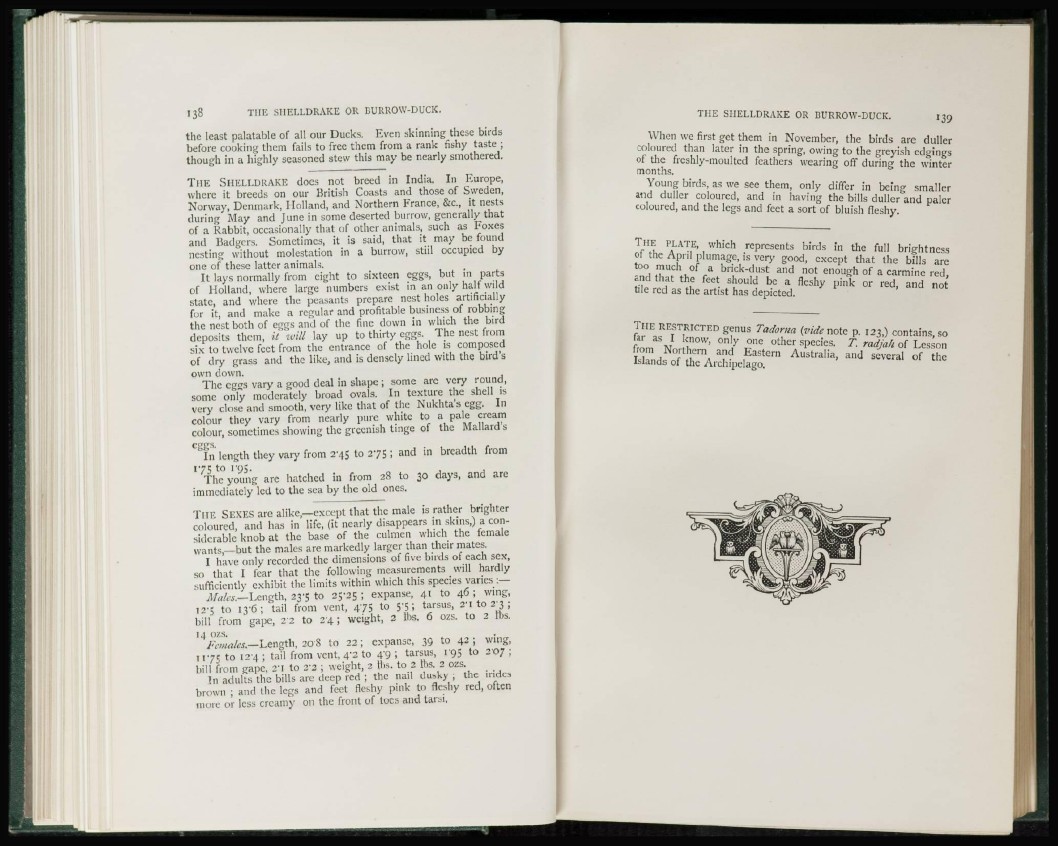
' 38 THE SHELLDRAKE OR BURROW-DUCK.
the least palatable of all our Ducks. Even skinning these birds
before cooking them fails to free them from a rank fishy taste ;
though in a highly seasoned stew this may be nearly smothered.
THE SOELLDRAKE does not breed in India. In Europe,
where it breeds on our British Coasts and those of Sweden,
Norway, Denmark, Holland, and Northern France, &e, it nests
during May and June in some deserted burrow, generally that
of a Rabbit, occasionally that of other animals, such as Foxes
and Badgers. Sometimes, it is said, that it may be found
nesting without molestation in a burrow, stiil occupied by
one of these latter animals.
It lays normally from eight to sixteen eggs, but in parts
of Holland, where large numbers exist in an only half wild
state, and where the peasants prepare nest holes artificially
fur it, and make a regular and profitable business of robbing
the nest both of eggs and of the fine down in which the bird
deposits them, it will lay up to thirty eggs. The nest from
six to twelve feet from the entrance of the hole is composed
of dry grass and the like, and is densely lined with the bird's
own clown.
The eggs vary a good deal in shape ; some arc very round,
some only moderately broad ovals. In texture the shell is
very close and smooth, very like that of the Nukhta's egg. In
colour they vary from nearly pure white to a pale cream
colour, sometimes showing the greenish tinge of the Mallard's
eggs.
In length they vary from 2-45 to 2 7 5 ; and in breadth from
1 7 5 to 1-95.
The young are hatched in from 28 to 30 days, and are
immediately led to the sea by the old ones.
TlIE SEXES are alike,—except that the male is rather brighter
coloured, and has in life, (it nearly disappears in skins,) a considerable
knob at the base of the culmen which the female
wants,—but the males are markedly larger than their mates.
I have only recorded the dimensions of five birds of each sex,
so that I fear that the following measurements will hardly
sufficiently exhibit the limits within which this species varies :—
Males.—Length, 23-5 to 25-25 ; expanse, 41 to 46 ; wing,
12-5 to 1 3 6 ; tail from vent, 4 7 5 to 5-5 ; tarsus, 2' i to 2 3 ;
bill from gape, 2 2 to 2 4 ; weight, 2 lbs. 6 ozs. to 2 lbs.
14 ozs.
Females,—Length, 20 S to 22 ; expanse, 39 to 42 ; wing,
1 1 7 5 to 1 2 4 ; tail from vent, 4-2 to 4-9 ; tarsus, 1 9 5 to 2 0 7 ;
bill from gape, 2 T to 2'2 ; weight, 2 lbs. to 2 lbs. 2 ozs.
In adults the bills are deep red ; the nail dusky ; the irides
brown ; and the legs and feet fleshy pink to fleshy red, often
more or less creamy on the front of toes and tarsi.
THE SHELLDRAKE OR BURROW-DUCK. ' 39
When we first get them in November, the birds are duller
coloured than later in the spring, owing to the greyish edgings
of the freshly-moulted feathers wearing off during the winter
months.
Young birds, as we see them, only differ in being smaller
and duller coloured, and in having the bills duller and paler
coloured, and the legs and feet a sort of bluish fleshy.
fl L A T , E ' , W h l 0 h r e P r e s e n t s
b''rds in the full brightness
A
ot the April plumage, is very good, except that the bills are
= n°l Tf\u / ^ - ^ t and not enough of a carmine red,
and that the feet should be a fleshy pink or red, and not
tile red as the artist has depicted.
T H E RESTRICTED genus Tadorna (vide note p. 123,) contains, so
from "M ^ " ° W ' ° n i y
Z n e o t h e r s P e c i e s - T - " ^ M of Lesson
^SS^i^S^ AustraIia'and several of the